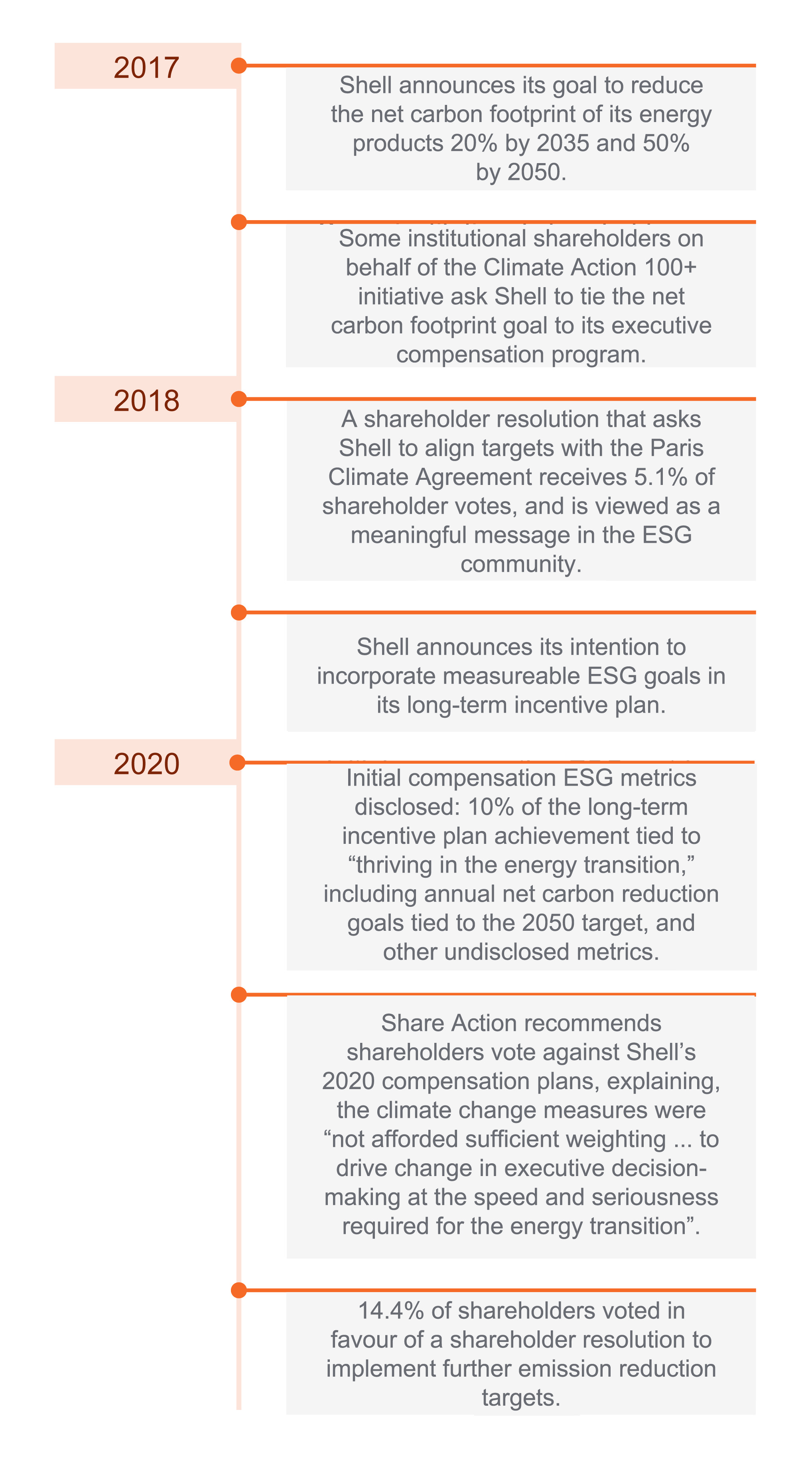Discussions on environmental, social, and governance (“ESG”) topics are not new to companies in the energy sector. While oil and gas companies may have previously been considered ESG laggards, this perception has changed over the years; in fact, many oil and gas companies were the first to incorporate ESG metrics in their compensation plans (albeit typically limited to measurable health and safety or operational measures). In December 2018, Royal Dutch Shell PLC (“Shell”), the British-Dutch oil and gas company, went a step beyond health and safety compliance when it announced it would incorporate carbon reduction metrics into its executive incentive plan.
This article examines the process Shell undertook in implementing these metrics, and the role shareholders played throughout.
Shell’s Carbon Reduction Goals & Executive Compensation Timeline
Source: Hugessen Consulting
 As illustrated by the timeline, Shell engaged with shareholders throughout the process of establishing carbon goals and incorporating those goals into the executive incentive plans. Although some shareholder resolutions received relatively low support (~5%), they still put the pressure on Shell by emphasizing their focus on ESG.
As illustrated by the timeline, Shell engaged with shareholders throughout the process of establishing carbon goals and incorporating those goals into the executive incentive plans. Although some shareholder resolutions received relatively low support (~5%), they still put the pressure on Shell by emphasizing their focus on ESG.
The response following Shell’s announcement that it would incorporate ESG metrics into incentive plans was somewhat surprising: ShareAction, a registered charity that promotes responsible investment, recommended voting against Shell’s compensation plan. This recommendation was driven by the fact that Shell’s 10% climate measure is outweighed in the Company’s compensation program by volume growth measures, which are achieved by increased fossil fuel output. While the introduction of a climate measure was a positive signal to shareholders, ShareAction argued that ultimately executives are still incentivized to “chase higher levels of … output” to the detriment of the climate and Shell’s long-term value. While it may initially appear as though the shareholder community was criticizing the very plan it had requested, in fact it was critiquing the effectiveness of the stated metrics. Given the media coverage of Shell’s initial announcement, it is no surprise that shareholders continued to follow the story closely and took this opportunity to signal their expectations to the market.
Shell’s approach to tying carbon reduction to executive compensation may still be a work in progress, but it has had a trickle-down effect throughout the oil and gas industry:
- In February 2019, Chevron announced that its goal of reducing methane and flaring intensity by 25-30% by 2023 (relative to 2016 levels) would be incorporated in an incentive scorecard for 45,000 employees.[1]
- In March 2020, BP announced that it would draft a shareholder resolution[2], committing to reach carbon neutrality by 2050.[3]
- In August 2020, Husky Energy announced it would tie executive compensation to a 25% reduction of GHG emissions intensity by 2023.[4]
We expect that shareholders will be energized by these examples of “first movers,” and will continue to put forward resolutions and engage with companies on ESG topics. Furthermore, while not publicly disclosed, we recognize that these case studies appear at almost every industry boardroom table and are top of mind for companies when they consider implementation in their organization.
Although ESG metrics have become more prevalent in compensation plans over the past few years,[5] there will surely be bumps in the road as companies attempt to answer the questions that come with the development of any performance-based compensation program: What metrics make sense? What is the appropriate weighting? Should they be part of the short-term or long-term compensation program? What should the leverage opportunity look like – and what happens if the goal is not met? Shell was one of the first to tackle these questions under the watchful gaze of its shareholders and the broader investor community. We expect more examples to be disclosed in the near term; in particular, we will see how shareholders react to new ESG measures and their view of alignment with performance, integration with the company’s corporate strategy, and the degree of transparency in the short-term and long-term metrics. There will certainly be more learnings to come from each company’s unique path in incorporating ESG metrics in their executive compensation programs.
Article Sources:
[1] Reuters: “Chevron ties executive pay to methane and flaring reduction targets”
[2] The resolution was developed in partnership with Follow This, and is intended to be presented at the FY2020 AGM
[3] Wall Street Journal: “BP Agrees to Draft Climate Change Shareholder Resolution”
[4] CBC: “Canadian oil giants emphasize climate change and diversity as they compete for investment“
[5] Hugessen Consulting: “Integrating ESG considerations into Executive Compensation Governance”
Timeline Sources:
- Hugessen Consulting: “News Flash: Royal Dutch Shell to Introduce Carbon Reduction Metrics in its Executive Compensation Program”
- Royal Dutch Shell FY2019 Annual Report
- ShareAction: “Shell’s and BP’s 2020 remuneration policies”
- Royal Dutch Shell FY2020 Notice of AGM
- Royal Dutch Shell 2020 AGM Voting Results



